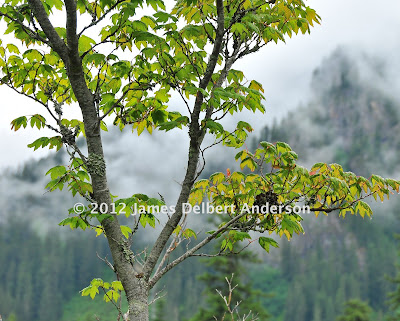On Saturday, I hiked the West Fork Foss Lakes trail...or, as it should rightfully be called, the Rocky Switchbacks of Doom trail. There's some very pretty scenery, including mountain-rimmed lakes, a view of a waterfall, a few wildflowers, huge old-growth trees, etc. All this comes, however, at a high price. The path up to Copper Lake is quite steep and rocky. Going uphill is a grueling slog; going downhill, while easier on the cardiovascular system, is very hard on the knees and ankles due to the steepness and the unrelenting uneven footing. I ended up getting a later start than I had wanted, starting my hike at about 9:30. I ended up feeling rushed to get up to Copper Lake and back while taking pictures. Still, I got some good ones and have a positive memory of the day.
This was probably my most successful shot of the evening. I wish the foreground leaves came out more strongly against the background...although some lighting work might at least help that. I find myself wondering whether making the falls more prominent in the frame would have been a good idea. This would seem like an obvious choice, but having them smaller makes the falls seem more far away and makes the leaves/forest seem more intimate.
Here is another one with a similar idea, with some advantages and disadvantages relative to the previous picture. The advantage is that the color of the leaves contrasts more strongly with the background. The disadvantage is that the leaves don't wrap around the falls as well as they do in the previous picture (the gap is on the right side).
Here is an interesting one of a fern opening. In addition to the depth of field effect, I wanted to highlight the contrast between the dull green of the old leaves and the bright green of the new. I used the widest aperture that my lens could muster at the time (f/3.2). I could have stood to have even wider, probably. But I had to stick with what was possible, and I think it worked okay.
This one is of some opening pearly everlasting flowers. The previous pictures were taken late in the evening; this one came from midday! Even though I found some shade, you can tell from the background that sunlight is lurking about. But I like the way that effect translated here. Also, I backed off from the widest possible aperture and used f/4 to get a slight detail boost in the in-focus petals, and some more definition in the out-of-focus flowers.
This columbine flower has a large rock in the background; I used f/8 to keep some definition in it. I am not sure if this image works or not, although I am inclined to think that it does.
Here is a good idea poorly executed. This plant is a Cooley's hedge nettle, and I liked the lighting - particularly the background, with varying shaded and sunlit leaves making for an interesting texture. The focus worked fairly well, too. Unfortunately, I didn't get things positioned brilliantly. There's some out-of-focus clutter at the bottom of the frame (even with cropping). The flowers on the sides could also have used a bit more space.
Up at the lake, I found an old friend: shooting star flowers! There were a few blooming in the grass right next to the lake. I stopped down all the way to f/14 for this shot - wider apertures did not give me enough definition in the mountains; I wanted them to be distinguishable and not just a pattern of gray and white blobs. Unfortunately, this produces some cluttering detail in the background among the grass and the splotchy clouds. I don't think this ruins the image, though.
While I was taking this shot, I was afraid that the light would be too harsh, even though it was slightly filtered by a few clouds. Upon looking at it on my computer, however, I think the lighting is acceptable. Later evening light would have been better - but I had to make sure I had time to get back to my car without stumbling down the Rocky Switchbacks of Doom in the dark. I also like how the perspective turned out.
Also from the lake, some reflections. Much of the lake surface was actually a bit choppy, as mountain lakes go; some logjams created some stiller areas, though. I am not sure if the mountain is distinguishable enough as a reflection of a mountain.
If I were to give a title to the next one, I think I would choose something like "leaning giants." The straight young tree on the left-hand side gives a sense of vertical orientation, highlighting the lean of the old trunks.
Another old-growth forest scene; I liked the lines these branches made against the two old trunks.
This one came near the beginning of the hike; I often find plants growing on stumps and logs but usually not flowers in such concentration. I tried some perspectives with some more depth - I moved to the left and closer - but this ended up detracting from the image, since it was a lot harder to tell what was actually going on.
A few other nice shots:
And we'll end where we began, with waterfall pictures. I'm not sure if I like this one, due to the extent to which the leaves intrude on the waterfall. Still, I thought it'd be worth a post.
























































